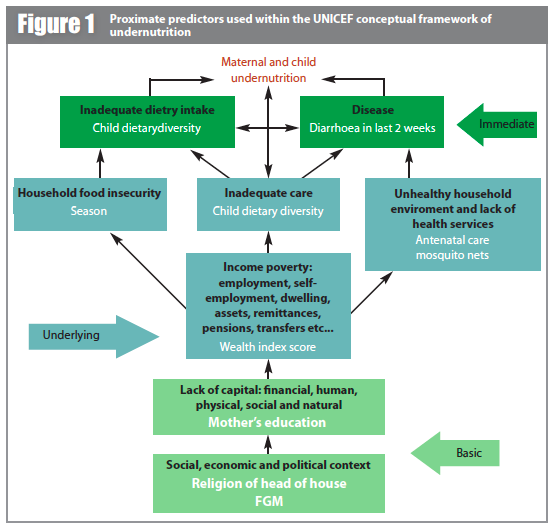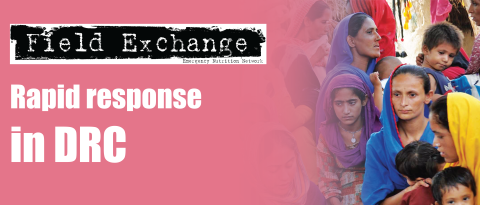Predicting coexistence of wasting and stunting in Guinea-Bissau: A secondary data analysis
Summary of MSc thesis1
By Abbi Sage
Abbi Sage is a recent MSc graduate in Nutrition for Global Health from the London School of Hygiene and Tropical Medicine. She is now part of the Knowledge Management Team of the Nutrition Division of the World Food Programme.
The author acknowledges her supervisor, Suneetha Kadiyala, and co-supervisor, Helen Harris-Fry, for their joint support.
Location: Guinea-Bissau
What we know: A child who is both wasted and stunted has higher associated morbidity and mortality.
What this article adds: This secondary analysis of 2014 MICS data identified socioeconomic and health factors that are associated with concurrent wasting and stunting in children aged 6-59 months in Guinea-Bissau. Six per cent of 6,602 children analysed were wasted (1% severely wasted); 30% were stunted (9% severe); 2.4% of children were both wasted and stunted. Of those stunted, 8.2% were wasted; of those wasted, 40.7% were stunted. Most children (86.2%) did not meet minimum dietary diversity. The largest maternal age group was adolescents (15-19 years) (23%). Concurrent wasting and stunting was more prevalent in boys than girls by 24%. Both observed mosquito net in the house and lack of diarrhoea in the last two weeks were protective of concurrent wasting and stunting. More surprisingly, richer children were 2.27 times more likely to be wasted than the poorest children. The findings reiterate the importance of considering concurrent wasting and stunting in undernourished children for policy and programming.
Background
Wasting and stunting are commonly considered as separate undernutrition conditions in programming and policy worldwide. Recent evidence points to the correlative nature of the two conditions and suggests that a child who is moderately wasted and stunted at the same time is at far higher risk of mortality compared to a severely wasted or stunted child (Khara T, Dolan C, 2014).
With an estimated population of 1.8 million, Guinea-Bissau has a high infant mortality rate at 77.9 per 1,000 births. In 2015, the under-5 mortality rate was even higher at 124 per 1,000 live births (12.4%). Political instability means 70% of the population live in poverty. Food insecurity, seasonal changes in rainfall, poor infant and young child feeding (IYCF) practices, poor water and sanitation, and inadequate health services result in undernutrition being a major public health concern; prevalence of chronic undernutrition is above 25%.
The overall aim of this study was to identify socioeconomic and health factors that are associated with the coexistence of wasting and stunting in children between the age of 6-59 months in Guinea-Bissau. Specific objectives were:
- To characterise patterns of stunting and wasting, with specific focus on the coexistence of stunting and wasting;
- To identify associations between hypothesised socioeconomic and demographic determinants of wasting and stunting separately, and the coexistence of wasting and stunting.
Study methods
Data from a UNICEF Multiple Indicator Cluster Survey (MICS) published in 2014 were used for this secondary data analysis. Only participants in the MICS that met the eligibility criteria outlined below were included in the analysis. A total of 6,602 children living in 4,016 households and 5,303 mothers were included in the final analysis.
Inclusion criteria:
- Children 6-59 months of age with data on both weight-for-height z score (WHZ) and height-for-age (HAZ) and the mothers/caregivers of those infants.
Exclusion criteria:
- Women aged 15-49 years in original survey who did not have children 0-5 years of age;
- Households without children under five years of age;
- Anthropometry outliers using the World Health Organisation (WHO) cut-off criteria of >5.00 & <-6.00 z-scores;
- Infants 0-6 months of age (due to programmatic and biological differences in dealing with wasting or stunting in infants aged 0-6 months compared to children aged 6-59 months).
Using the UNICEF conceptual framework of undernutrition, indicators from the original survey were used as proxy measures for more commonly used indicators, based on prior literature. In this study, the immediate predictors were considered at the individual level of the child, while the underlying and basic predictors are at the maternal and household level (see Figure 1).

*Female Genital Mutilation (FGM) was included in the model due to Guinea-Bissau’s high rate of this practice, used as a proxy indicator for women’s empowerment.
Univariate, multinomial logistic regression was initially used to investigate crude relationships between covariates and wasting; stunting; and wasting and stunting combined, compared to not wasted or not stunted children. Variables in the univariate analysis with a small sample size due to missing values were not included in the multivariable regression. The multivariable regression results were deemed statistically significant if covariates produced a p-value of ≤0.05. All analyses accounted for the clustered sample design.
Findings
Child determinants
Of 6,602 children, 3,257 were girls (49.3%). The mean age of all children was 32 months (95% CI 31.4, 32.3); 63.3% (4,862) of the children were from a rural setting.
For children aged 6-23 months, 86.2% did not meet minimum dietary diversity, with the median being two food groups (IQR 1.5, 2.5). Of note, 43.1% of information on child dietary diversity was missing. A total of 12.6% of children had diarrhoea in the previous two weeks; children aged 6-11 months had the highest prevalence of diarrhoea at 25.4%.
Maternal determinants
The median age of mother/caregivers was 27 years (IQR 26.5, 27.5); the largest group of mothers were adolescents themselves (23%), aged 15-19 years old. Approximately 60% of mothers had no formal education. Most (92.2%) of women claimed to have had antenatal care during pregnancy, however 67.7% of the data were missing.
Household determinants
Most (97%) households had an observed mosquito net. Once disaggregated by anthropometric deficit, almost 10% of wasted and stunted children did not have a mosquito net in their house, followed by 5% of wasted children compared to 3% of not stunted or wasted children and 2% of stunted children. Roughly half of households were Muslim and approximately one third of mothers had undergone genital mutilation. The poorest wealth index had the highest percentage of female genital mutilation (29%).
Wasting
Six per cent of children were wasted, of whom 1% were severely wasted. Among all the predictors tested in the multivariate model, a child whose mother had undergone FGM had a reduced risk of wasting by 31% (p-value 0.05). Taking a closer look at this result, the confidence interval crosses one (0.47, 1.01), reducing the certainty of the significance which could be a result of the arbitrary p-value cut-off.
Surprisingly, there were more wasted children who were wealthy compared to the poorest in the sample population being studied. Children with a richer wealth index were 2.27 times more likely to be wasted than children with the poorest wealth index (p-value 0.006). One explanation for this association may be that more children were wasted in urban areas than rural areas (4.2% and 3.2% respectively). It may not be the case that a higher wealth index predicts wasting but that, in this population, children were more likely to be wasted due to the higher percentage of wasted children living in urban areas, where wealth index scores were generally higher. The urban capital, Sector Autónomo de Bissau (SAB), had the highest percentage of wasting compared to all other regions. Future research is needed into the current state of children in urban settings in Guinea-Bissau, particularly SAB, to understand the factors at play with this association.
Stunting
Approximately 30% of children were stunted, with severe stunting at 9%. In the multivariate model all age groups had a strongly significant higher risk of being stunted compared to 6-11 month old children (p-value <0.001). There was weak evidence that children who had an educated mother at secondary level were almost 30% less at risk of being stunted than those who had an uneducated mother (p-value 0.045). Children from the richer and richest wealth index were 46% and 63% respectively less at risk of being stunted than children from the poorest wealth index (p-values <0.001).
Wasting and stunting
Only 2.4% of children aged 6-59 months were both wasted and stunted at the time of the survey; however, of those stunted, 8.2% were wasted and of those who were wasted, 40.7% were stunted. No wasting, no stunting, and wasting and stunting individually were distributed equally across girls and boys. However, boys were 24% more concurrently wasted and stunted than girls.
In the multivariate analysis, children who had diarrhoea in the last two weeks were 75% more at risk of being both wasted and stunted than those who did not, relative to children who were neither wasted or stunted (p-value 0.022). There was strong evidence that having a mosquito net in the household decreased a child’s risk of being both wasted and stunted by 78% compared to not having a mosquito net (p-value 0.003).
Due to the small sample size of the psychosocial stimulation predictor, a separate multivariate regression adjusting for sex, child age, mother age and wealth index was created. There was weak evidence for a protective association between psychosocial stimulation and wasting and stunting (N=2,744). For every additional person to engage in cognitively engaging activities with the child, the child had a 15% lower risk of being concurrently wasted and stunted, relative to a not stunted or wasted child (p-value 0.043).
Discussion
This study has highlighted that associations that are insignificant for wasting and stunting individually become significant once wasting and stunting coexists in a child in Guinea-Bissau. In particular, observed mosquito net in the house and lack of diarrhoea in the last two weeks were both protective of concurrent wasting and stunting.
Approximately 30% of children were stunted (WHO high public health concern), while 6% were wasted (WHO medium public health concern). Due to the cross-sectional nature of the data, the prevalence of wasting seen here may not reflect the true prevalence of wasting in under-fives. Another limitation of this analysis is missing data, limiting the ability to test predictors such as dietary diversity and antenatal care.
The findings reiterate the importance of considering concurrent wasting and stunting when considering programming and policy to address undernutrition in Guinea-Bissau.
For more information, contact: Abbi Sage, abbisage12@gmail.com
Footnotes
1Sage, A. (2016). Secondary Data Analysis on the Coexistence of Wasting and Stunting in Children Under-5 in Guinea-Bissau using MICS 2014 data. MSc Nutrition for Global Health thesis, London School of Hygiene and Tropical Medicine
References
Khara T, Dolan C, 2014 Technical Briefing Paper: Associations between Wasting and Stunting, policy, programming and research implications. Emergency Nutrition Network: Emergency Nutrition Network, 2014.


